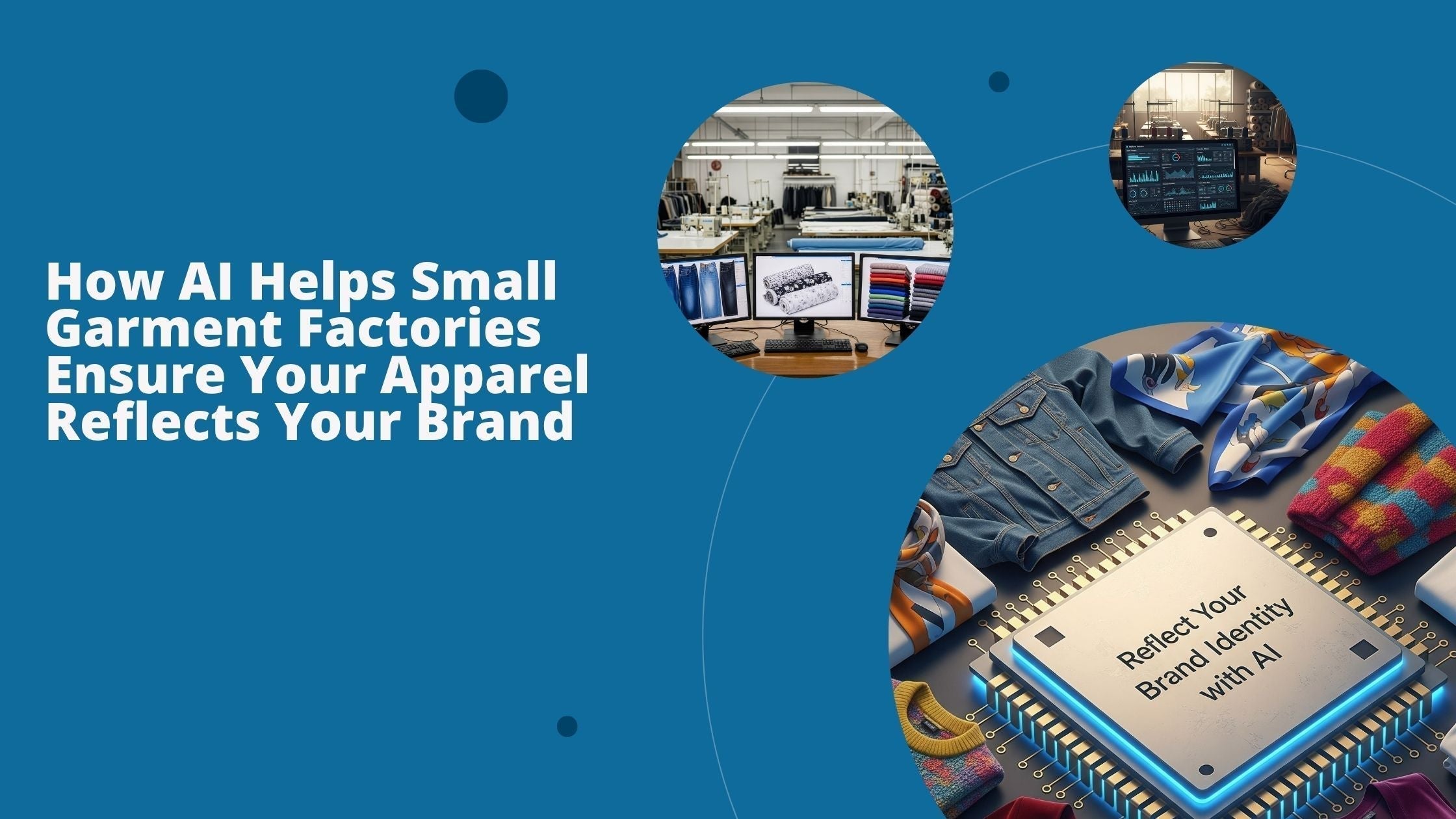How AI Helps Small Garment Factories Ensure Your Apparel Reflects Your Brand
| Aug, 06 , 25
The Power of Brand Story in Apparel
For small garment factories looking to partner with emerging brands, understanding the distinction between a logo and a brand is crucial. A logo is simply a visual symbol, while a brand embodies a much deeper meaning—it's the essence of a company and its core identity. This identity is built upon three fundamental pillars: mission, vision, and values. Defining these elements before embarking on product development is paramount. Simply printing a logo on generic garments, a common practice for some small garment factories, is insufficient for building a strong brand. In today's crowded market, where numerous brands compete for consumer attention, differentiation is crucial. Without a clear mission, vision, and values, brands risk blending into the background, their products becoming just another commodity. This critical initial step of defining brand identity remains largely human-driven, requiring creative thinking and strategic planning that AI cannot fully replicate.

A Logo Isn't a Brand: Defining Your Core Identity
If you're a brand working with a small garment factory, remember this: a logo is not your brand. It's a visual representation, but it doesn't tell the whole story. Before even thinking about designs or fabrics, you must define your core identity: your mission (your purpose), your vision (your aspirations), and your values (your guiding principles). It is vital for small garment factories, which often work with numerous brands, to understand the distinct identity of each. Simply slapping a logo on a generic t-shirt, a quick and easy approach, won't cut it in today's competitive landscape. Consumers like brands that resonate with them on a deeper level. Differentiation is paramount, and it starts with a strong understanding of your brand's DNA. This crucial stage of brand definition is a human-driven process that relies on creativity, strategic thinking, and a deep understanding.

Audience Insights for Stronger Market Position
Brand positioning is the art of creating a clear and compelling space for a brand in the consumer's mind. For small garment factories collaborating with brands, this means understanding not just what products to manufacture, but also why those products matter to the target audience. The "why" is the brand's story, its values, and the emotional connection it forges with its customers. It's far more potent than simply focusing on product features or price points. Small garment factories can leverage AI tools to support their brand partners in this crucial positioning process. AI algorithms analyze data from diverse sources, including social media, online reviews, and sales data. It can precisely identify emerging trends, consumer preferences, and unmet needs. This information enables small factories to provide valuable insights to brands, enabling them to position themselves effectively within the market. Additionally, sentiment analysis enables small garment factories to provide brands with a deeper understanding of consumer perceptions. They can identify and meet needs and market opportunities.

Constructing the Apparel Line: From Concept to Creation
Brands seeking to partner with small garment factories are increasingly looking for partners who can offer innovative solutions and efficient production processes. AI provides these solutions, empowering small garment factories to serve their brand partners better:
-
AI-driven design and pattern making: Brands can benefit from faster design iterations and more accurate patterns.
-
3D virtual prototyping and simulation: This advanced technology allows brands to visualize their designs more effectively. Designers can create virtual models of their garments and simulate how they would look and function in the real world. This process enables them to make changes early in the design phase, reducing the need for costly and time-consuming physical samples.
-
AI-powered fabric selection and optimization: Brands can be confident that their products are being made with the most suitable and cost-effective materials, while also minimizing environmental impact. By analyzing a wide range of fabric properties and considering factors such as cost and availability, AI can help small garment factories make more sustainable choices, thereby reducing waste and their environmental footprint.
-
Predictive analytics for demand forecasting: AI-driven insights empower brands to fine-tune their inventory, guaranteeing the correct items are available in optimal quantities precisely when needed.
AI-driven quality control ensures that the final products meet the brand's quality standards, thereby protecting its reputation and fostering customer trust. It is achieved through a combination of AI algorithms and human oversight, where the AI system identifies potential quality issues and human inspectors verify and approve the final product, maintaining the human touch in quality control.

Case Study: EverLighten and the Power of AI-Driven Apparel Development
EverLighten, a leading custom apparel manufacturer, has embraced the transformative potential of AI to revolutionize its product development process. By integrating AI-powered solutions, EverLighten has achieved remarkable results, enhancing efficiency, reducing costs, and ensuring that its apparel offerings align with the needs of its target audiences.
AI: Your Key to Deeper Audience Understanding
Traditionally, EverLighten relied on market research and customer feedback to define its audience categories. However, with the integration of AI, the company can now leverage vast amounts of data to gain a deeper understanding of its customers. AI algorithms sift through data from various sources, including social media, online reviews, and sales figures. This data-driven approach allows EverLighten to refine its audience categories, ensuring that its apparel offerings are tailored to specific customer segments.
Faster Designing and Prototyping with AI
AI has also transformed EverLighten's design and prototyping process. By implementing AI-driven design tools, the company can automate pattern creation, reducing manual drafting time and minimizing errors. Furthermore, AI-powered 3D virtual prototyping allows designers to visualize garments on virtual models, eliminating the need for multiple physical samples. It not only saves time and resources but also reduces material waste, contributing to EverLighten's sustainability efforts.
Smarter Fabric Choices with AI
Choosing the right fabric is crucial for apparel performance and cost-effectiveness. EverLighten strategically utilizes AI algorithms to analyze fabric properties, cost, and availability, ensuring that the selected materials meet the specific requirements of each apparel. This data-driven approach not only optimizes fabric selection but also minimizes waste and maximizes cost savings, providing reassurance to the audience about the quality and cost-effectiveness of their products.
Real-World Impact
The integration of AI has yielded significant benefits for EverLighten. The company has experienced a 20% reduction in sample development time, a 15% decrease in material waste, and a 12% improvement in product quality. These results demonstrate the tangible impact of AI on apparel manufacturing, inspiring the audience and giving them hope about the potential of AI in their businesses.

Benefits of AI for Small Garment Factories:
The benefits of AI in apparel manufacturing extend to both small garment factories and the brands they collaborate with. It is a mutually beneficial partnership:
-
Reduced lead times: Faster turnaround times enable brands to bring their products to market more quickly, allowing them to respond to trends and meet consumer demand more effectively. It also allows small garment factories to undertake more projects and boost their revenue.
-
Lower costs: Reduced costs benefit both parties. Brands can access high-quality production at more competitive prices, while small garment factories can increase their profit margins.
-
Improved quality and fit: Higher quality and consistent fit enhance brand reputation and customer satisfaction, leading to increased sales and repeat business for both the brand and the factory.
-
Increased efficiency and scalability: Small garment factories can handle larger volumes of orders and work with more brands, expanding their business and creating more growth opportunities.
-
Data-driven decision-making: Shared data insights empower both brands and small garment factories to make informed decisions about design, production, and marketing, leading to more successful product launches and stronger business relationships.
-
Enhanced brand consistency: AI ensures that the brand's vision is accurately translated into every garment, strengthening brand identity and building customer loyalty. This consistency benefits both the brand and the small garment factory by fostering a long-term, mutually beneficial partnership.

Overcoming Challenges and Implementation:
Many small garment factory owners may hesitate to adopt AI due to concerns about cost, technical expertise, and the potential disruption to their existing workflows. However, these concerns can be addressed with a strategic and practical approach:
-
Cost: While some AI solutions can be expensive, many affordable options are available, especially cloud-based solutions. Starting with a small pilot project can minimize initial investment and demonstrate ROI before committing to larger implementations. This approach also enables brands to see the value without incurring a significant initial investment.
-
Complexity: User-friendly AI tools and partnerships with technology providers can simplify the implementation process. Training staff on these new tools is also crucial, but many providers offer training resources and support.
-
Disruption to workflows: Implementing AI doesn't require completely overhauling existing workflows. Starting with focused pilot projects allows small garment factories to gradually integrate AI into their operations, minimizing disruption and allowing staff to adapt to the new technologies.
-
Data collection and analysis: Starting small allows small garment factories to focus on collecting and analyzing the most relevant data for their pilot project. As they become more comfortable with AI, they can expand their data collection efforts and leverage more advanced analytics. Sharing this data with brands can demonstrate the value of the factory's investment in AI.

Conclusion: AI as a Brand-Building Tool
The future of apparel manufacturing is here, and AI powers it. Small garment factories and brands that embrace these technologies will be best positioned for success in the years to come. At EverLighten, we're committed to helping businesses of all sizes leverage the power of AI to create exceptional apparel. We offer a comprehensive suite of services, including:
-
100% Customization: From design to print and garment construction, we offer complete customization to meet your exact specifications.
-
Comprehensive Quality Check: Our rigorous quality control processes ensure that every printed garment meets the highest standards of quality and craftsmanship.
-
Free Design Help: Our experienced design team is here to assist you with design development, print optimization, and file preparation.
-
Worldwide Delivery: We provide reliable and efficient shipping to reach your customers wherever they are, worldwide.
-
24/7 Support: We provide 24/7 help to solve your queries.
-
Unlimited Revisions: You can revise the design until you're 100% content with the final product.
-
Low MOQ (Minimum Order Quantity): We offer a flexible MOQ to accommodate businesses of all sizes.
Ready to partner with a leading AI-driven apparel manufacturer? Contact EverLighten today!
FAQs:
Q: How can AI help small garment factories reduce costs?
-
A: AI can reduce costs by minimizing material waste through optimized cutting, reducing labor costs through automation, and eliminating the need for multiple physical samples through virtual prototyping.
Q: What is AI-powered sentiment analysis, and how is it used in apparel manufacturing?
-
A: AI-powered sentiment analysis analyzes text data from sources like social media and online reviews to understand consumer opinions and perceptions. It helps small garment factories and brands identify market trends and opportunities.
Q: Is implementing AI expensive for small garment factories?
-
A: While some AI solutions can be costly, many affordable and user-friendly options are available, especially cloud-based solutions. Starting with pilot projects and partnering with technology providers can also help manage costs.
Q: What are the benefits of partnering with an AI-driven apparel manufacturer like EverLighten?
-
A: Partnering with EverLighten offers numerous benefits, including faster turnaround times, lower costs, improved quality, enhanced brand consistency, and access to expert design and support services. Our low MOQ makes custom apparel accessible to businesses of all sizes.

